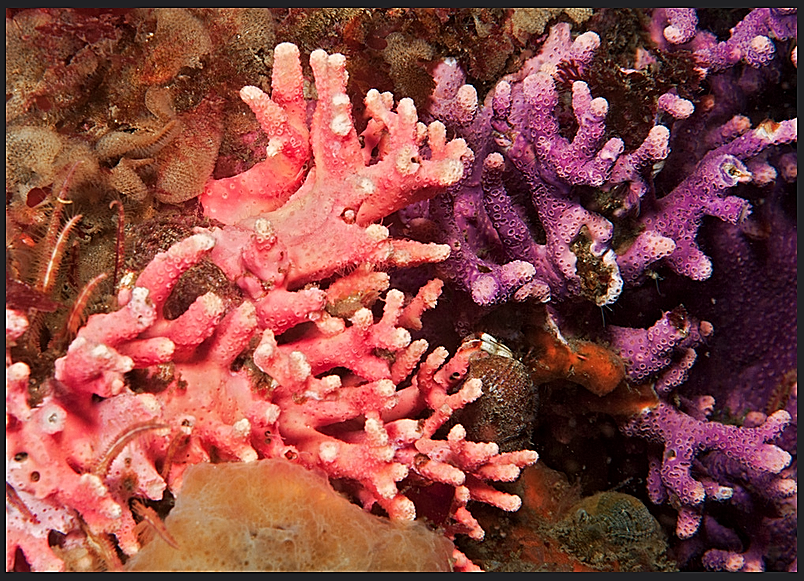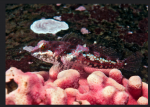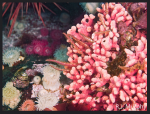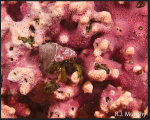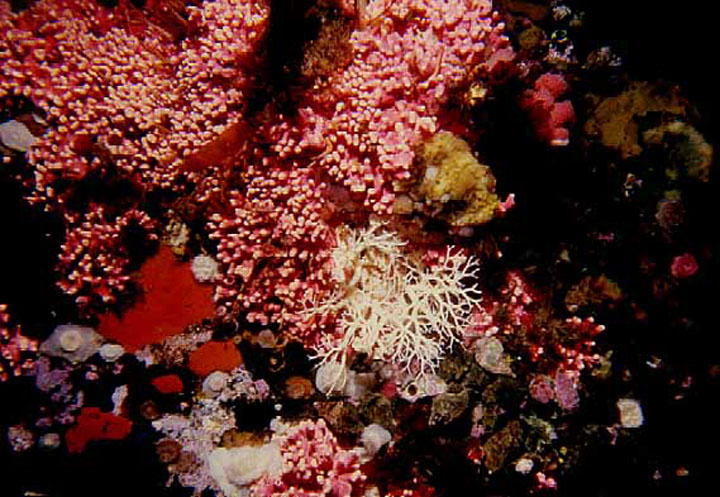
A bed of Stylaster parageus columbiensis. in front of the docks at Race Rocks off peg #2 at 10 meters. Note the basket star, clumps of whelks and patches of red encrusting sponge.picture width : 80cm.
This colonial hydroid grows from the 0.2 tidal level to over 20 meters in depth in various places throughout the Race Rocks Ecological Reservee. At low tide, it is visible in several protected crevices and in Anita’s tidepool ( #6 on the West shore) Subtidally it is common in both purple and pink colonies . East of the Middle Islands, it has been observed by divers at 20 meters, growing in erect branching form of considerable profile ( to 20 centimeters.)
| Domain | Eukarya |
| Kingdom | Animalia |
| Phylum | Cnidaria |
| Class | Hydrozoa |
| Order | Anthoathecata) |
| Family | Stylasteriidae |
| Genus | Stylaster |
| Species | parageus columbiensis (Lindner & Cairns) |
| Common Name: | Hydrocoral |
In July of 2002, Dr. Anita Brinckmann-Voss of Sooke had Alberto Lindner, a PhD student from Duke University visiting to exchange scientific information and to get help with identification of hydroids from collections in Alaska and the Olympic Penninsula. Alberto is studying the systematics and evolution of hydrocorals using morphological and molecular biology methods for his Ph.D. thesis. His supervisor and advisors are Dr. Stephen Cairns (Smithsonian) , Dr.Chris Cunningham (Duke University) and Dr. Dale Calder (Royal Ontario Museum) This is part of a program of training young zoologists in established and new methods of sytematics. Alberto comes from Brazil, having completed a Master’s degree in the University of Sao Paolo.
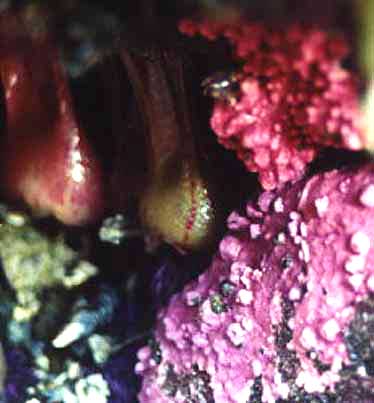 Anita made arrangements with us to get Alberto to the islands so that he could see Allopora growing in its natural habitat. Although it was not a zero tide level, we were still able to collect several small samples for him to do DNA analysis. He hoped to be able to sort out whether or not there is a distinct species difference in the color varieties we find at Race Rocks.
Anita made arrangements with us to get Alberto to the islands so that he could see Allopora growing in its natural habitat. Although it was not a zero tide level, we were still able to collect several small samples for him to do DNA analysis. He hoped to be able to sort out whether or not there is a distinct species difference in the color varieties we find at Race Rocks.
After returning to his lab and doing further analysis, Alberto reported that “It is pretty safe to say that the purple and pink color morphs of Stylaster corals (Allopora) from Race Rocks are the same species”. He has also noted the same result with deep-sea species from the Aleutians, as the orange and pink forms there do not separate the species.
See the record of his research on species identification here: Stylaster parageus columbiensis Lindner & Cairns in Cairns & Lindner, 2011
The following images were taken by the Ecoguardian Ryan Murphy in 2010. many different species including basket star in the image above have adapted to use the hydrocoral as a habitat because of it’s protective crevasses.
- A sculpin’s cryptic coloration helps it to blend into the hydrocoral background
- Arms of serpent stars protrude from the protective cover of hydrocoral
- A hermit crab with various encrustations against the hydrocoral background
- A feather tube worm grows out from the hydrocoral
see this link for other hydroids: https://www.racerocks.ca/tag/hydroid/
This file is provided as part of a collaborative effort by Lester B. Pearson College students, staff, volunteers and local scientists.

